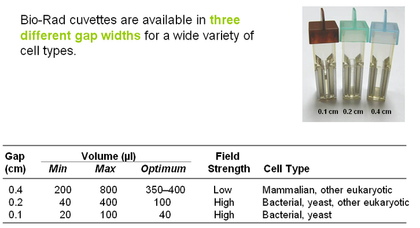Lidstrom:Transformation: Difference between revisions
From OpenWetWare
Jump to navigationJump to search
| Line 30: | Line 30: | ||
****Note: you can dilute your re-suspension, measure OD, and calculate the cell concentration if you care. See [[Electrocompetent_Cells| this page]]. Would allow you to calculate efficiency. | ****Note: you can dilute your re-suspension, measure OD, and calculate the cell concentration if you care. See [[Electrocompetent_Cells| this page]]. Would allow you to calculate efficiency. | ||
===Preparing Cuvettes=== | ===Preparing Cuvettes=== | ||
*Soak in water, rinse with DI water, fill with EtOH overnight, discard EtOH, and dry under UV light. | *Soak in water, rinse with DI water, fill with EtOH overnight, discard EtOH, and dry under UV light. | ||
*Do not autoclave: plastic will melt. | *Do not autoclave: plastic will melt. | ||
**Use [http://www.bio-rad.com/prd/en/US/adirect/biorad?cmd=catProductDetail&vertical=LSR&country=US&lang=en&productID=165-2083 brown capped cuvettes for E. Coli]. | |||
**[[Janet B. Matsen|Janet]] called BioRad on 4/2012 and they said ethanol sterilization is fine, but do not autoclave or the plastic will melt. They want you to buy new ones every time instead, but that is silly. | |||
===Transforming Cells=== | ===Transforming Cells=== | ||
Revision as of 13:25, 1 June 2012
Back to Protocols
You can chose between chemically competent cells and electrocompetent cells. Andrew makes chemically competent cells for the lab to use. Several strains are kept in stock in the -80oC freezer.
Using Chemically Competent Cells
- Thaw frozen (-80oC) competent cells on ice.
- You REALLY dont want it to get too warm; add plasmids while it is still slushy.
- Add 1-10 uL DNA
- 10 uL if ligated plasmid. Use only 1 uL if regular plasmid from miniprep
- Incubate @ 42oC for 45 sec - 1 min
- Incubate on ice for 2 min
- Add 1 mL LB
- Sandy, Ceci, & Janet use 500 uL
- Incubate at 37oC for 45 min - 1 hr in eppendorf tubes
- Ideally shaking though it may not matter. You can tape your tubes to a rack in the shaker. Tape them well if you do -- they fly off!
- Pellet cells by centrifugation
- keep the ~100 uL droplet after you pour it off (Andrew)
- Plate 50-100 uL cells on LB (+antibiotic(s)) agar plate
- If you are worried about having a lawn, do one plate with more cells and dilute a fraction of the cells and plate a diluted aliquot.
Electrocompetent Cells (in progress)
Preparing Cells
- You can make your own electro competent cells.
- From Amada's past mentor in undergrad:
- Grow the cells overnight
- Inoculate from this the next morning: generally use 200 uL/50 mL
- Let grow for about 3-4 h (OD 0.4-0.6 or so), then centrifuge and wash 3 times with 10% glycerol (everything on ice).
- Resuspend the pellet in a small volume (Example, if I do a 5 ml culture I try to resuspend the final pellet in no more than 0.2 or 0.3 ml of 10% glycerol). Then split in 1.5 ml centrifuge tubes (0.1 ml in each), freeze on dry ice-isopropanol and store at -80C.
- Note: you can dilute your re-suspension, measure OD, and calculate the cell concentration if you care. See this page. Would allow you to calculate efficiency.
- From Amada's past mentor in undergrad:
Preparing Cuvettes
- Soak in water, rinse with DI water, fill with EtOH overnight, discard EtOH, and dry under UV light.
- Do not autoclave: plastic will melt.
- Use brown capped cuvettes for E. Coli.
- Janet called BioRad on 4/2012 and they said ethanol sterilization is fine, but do not autoclave or the plastic will melt. They want you to buy new ones every time instead, but that is silly.
Transforming Cells
- use ice cold electrocompetent cells
- mix in 1-2 uL DNA; gently mix to prevent shear stress on cells & DNA
- transfer mixture to sterile cuvette
- make sure there are no bubbles or it could arc (bad for your cells)
- settings for E. Coli:
- brown-caped 1 mm gap tubes:
- 1.8 kV, 200 Ohms, 25 uF.
- green-capped 2 mm cuvette: (in case you don't have brown cuvettes ready)
- 2.5 to 3.0 KV, 200 Ohms, 25 uF
- brown-caped 1 mm gap tubes:
- Shock them by pressing both buttons on our BioRad electroporation machine.
- Press long enough to hear the machine beep.
- Transfer cells to sterile 1.5 mL tubes filled with SOC media that have been chilled on ice
- Record time constant displayed by machine (should be ~ 5-6)
- Alternately, add ~950 uL ice cold SOC media to cuvette & transfer to ice-cold sterilized cuvette as fast of possible.
- Note: Janet is going to try just using LB instead to save prep time. Mila/Marina guesstimated that using SOC may give you ~2 fold better yield than SOC.
- Fast --> less cells die.
- Chill sample on ice for 2 mins to permit the cells to recover.
- Transfer eppendorf tube to 37°C incubator and shake to promote aeration. Incubate for 1 hr to permit expression of antibiotic resistance gene.
- Plate transformation onto prewarmed LB-agar plate supplemented with appropriate antibiotic. I generally plate 200μL but appropriate plating volume depends on efficiency of the transformation.
- Incubate plate overnight at 37°C.
- Leave remaining SOC-cell mixture on the benchtop overnight.
- If you don't have any transformants, plate the rest of the transformation in the morning.
Notes
- When choosing the # of vials and cuvettes, be sure to include 2 vials for two negative controls (one with no DNA added, and another with only cut vector added).
- Cuvette types:

- BioRad Movie about electroporation. Though it is made for a different machine than we have, the principles are applicable.